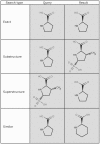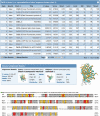The RCSB Protein Data Bank: redesigned web site and web services
- PMID: 21036868
- PMCID: PMC3013649
- DOI: 10.1093/nar/gkq1021
The RCSB Protein Data Bank: redesigned web site and web services
Abstract
The RCSB Protein Data Bank (RCSB PDB) web site (http://www.pdb.org) has been redesigned to increase usability and to cater to a larger and more diverse user base. This article describes key enhancements and new features that fall into the following categories: (i) query and analysis tools for chemical structure searching, query refinement, tabulation and export of query results; (ii) web site customization and new structure alerts; (iii) pair-wise and representative protein structure alignments; (iv) visualization of large assemblies; (v) integration of structural data with the open access literature and binding affinity data; and (vi) web services and web widgets to facilitate integration of PDB data and tools with other resources. These improvements enable a range of new possibilities to analyze and understand structure data. The next generation of the RCSB PDB web site, as described here, provides a rich resource for research and education.
Figures





References
-
- Berman H, Henrick K, Nakamura H. Announcing the worldwide Protein Data Bank. Nat. Struct. Biol. 2003;10:980. - PubMed
-
- Dutta S, Burkhardt K, Young J, Swaminathan GJ, Matsuura T, Henrick K, Nakamura H, Berman HM. Data deposition and annotation at the Worldwide Protein Data Bank. Mol. Biotechnol. 2009;42:1–13. - PubMed
Publication types
MeSH terms
Substances
LinkOut - more resources
Full Text Sources
Other Literature Sources

